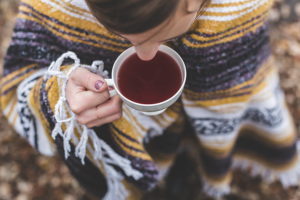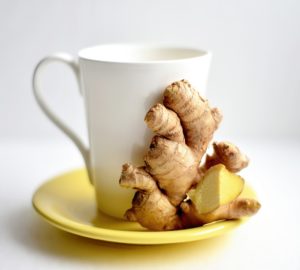Brewing Teas: Free Their Medicine
 As the days become shorter and we move further into the autumn season, let us embrace this Metal Element time of year. The Fall season is the body’s last attempt to rid itself of toxins and pathogens before Winter, when our bodies naturally slow down and rest.
As the days become shorter and we move further into the autumn season, let us embrace this Metal Element time of year. The Fall season is the body’s last attempt to rid itself of toxins and pathogens before Winter, when our bodies naturally slow down and rest.
Seasonal Health Refresher: The Metal Element expresses itself as the Lungs and Large Intestine. It is one of the five elements in Chinese Medical Theory. As Metal relates to autumn, Water relates to winter, Wood relates to spring, Fire relates to summer, and Earth is the transitional time between all of the seasons. Each element also relates to an organ pair. By having a clearer understanding of the seasons and seasonal living, we can enjoy a more balanced life and good health. Our health depends on understanding the seasons and the five element model empowers us and helps to keep our health optimal.
SPICES!
Fall is a time for spices. It’s a time to purge and detox. The flavor of the Metal Element is Spicy, but not necessarily spicy pepper hot. Spicy can be ginger, garlic, cloves, and cinnamon. As colder weather moves in, we generally transition from being outdoors to spending more time indoors and it’s nourishing and restorative to drink hot fluids, more specifically, hot teas. Although fall and winter in the South are still mild such that these seasons are lovely to spend time outdoors without the nuisance of heat and pesky insects, this is the perfect season for hot, spiced teas. In the South, we love our hot apple cider with cinnamon during this time of year and we may succumb to decadent baked goods that are baked with spices. However, they can be too sweet and cause congestion and suppress our immune response.
SO… spiced tea is a PERFECT drink choice for this time of year! My seasonal go tos are nettles, ginger and chai. I typically brew bulk herbs and tea leaves in a tea pot with a removable strainer. Loose herb and tea are higher quality and lower cost per cup if you rebrew the leaves a few times as they are intended. I brew until there is little color left (all the antioxidants, etc have been leeched). Often, I brew several batches from the same herbs and store in the fridge for later, sometimes mixing batches for fun. My Chinese Medicine teachers always packed their traveling suitcases with tea and spices. The ah too true joke with them is that packaged teas that we drink in this country are the sweepings off the factory floors from their country.
Nettles, though not spicy, is especially useful this time of year as it is a well known tonic for seasonal allergies. I often mix nettles with green tea (wake), peppermint (digest), or lavender (calm). Keep reading and give this underused weed a try! Another good choice to brew up is ginger root for colds and flu. Ginger is one of my favorites! Both can we sweetened with a little raw and local honey.
NETTLES 
Urtica dioica, also known as Common Nettle, Stinging Nettle or Nettle Leaf, or just as Nettle, is a herbaceous, perennial, flowering plant belonging to the family Urticaceae. Native to Europe, temperate Asia and western North Africa, today it is found globally, including New Zealand and North America. The plant has a long history of use as a traditional medicine, food, tea, and raw material. Stinging nettle does in fact sting because of its tiny hairs on the foliage that contain toxins. If you brush up against the leaves, you’ll get a sting that causes an itchy rash. Interestingly, with a little processing and preparation, it acts an anti-histamine, reducing the reactivity of allergic reactions. Stinging nettle is also used as a highly nutritious and mineralizing ingredient in soups, pastas, wild pate and as a greens side dis. To make the leaves edible, they are harvested while young, then wilted or boiled to neutralize the toxins. Nettles has a long history in treatment of urinary symptoms related to early stage prostate enlargement, fluid retention, gout, anemia and topically for strains, sprains, joint and muscle pain and a whole lot more.
Research and resources for nettles are clickable below.
Nettles nutrition, high in fiber and other nutrients
https://www.ncbi.nlm.nih.gov/pmc/articles/PMC4302403/
Nettles used for cardiovascular support and treatment of hypertension
https://plants.usda.gov/core/profile?symbol=URDI
CHAI: watch for our winter post on Chai
Let’s explore a few fall herbal teas and how to correctly brew them!
THERMAL NATURE & ORGAN AFFINITY (12 ORGAN NETWORKS)
Cinnamon : Cinnamomum cassia acrid, sweet, warm
- Twig, gui zhi– (warm) Upper body:
- heart, lungs, collaterals/channels
- with fresh ginger for joint arthritis, shoulder pain
- Bark, rou gui – (hot) Lower body:
- kidney, bladder, spleen
- tea stomach ache, abdominal swelling with cold signs
Turmeric: Curcuma longa acrid/pungent, bitter, cool
- Invigorates blood and breaks up stasis; Injury due to trauma, internal and external
- Promotes movement of qi: Chest, abdominal pain due to constrained liver qi with heat signs
- Clears heat and cools blood: Hot phlegm obstructing heart: anxiety, agitation, seizures
- Benefits gallbladder: Reduces jaundice improves
Ginger, Zingiber officianale acrid, hot
- Warms the middle jiao and expels cold
- Warms spleen and stomach
- Warms the lungs and transforms phlegm
- Warms the channels and stops bleeding from cold deficiency
Mints, Menta family: catnip, rosemary, oregano, basil
- Light flower floats to upper body.
- Antimicrobial: ECHO virus, salmonella bacteria
Peppermint, Mentha, piperita cool, pungent:
- releases: lungs, liver
- tea plus a little salt for pain (headache, trigeminal neuralgia, pain in mouth, throat, tongue, tooth, nosebleed)
- vents rashes – measles early stage
- common cold due to wind heat – scratchy throat, red eyes, fever
- disperses liver qi – pressure in chest and flank, unstable emotions, gynecologic
Spearmint Mentha spicata warm, pungent:
- calms spirit: heart
- stress induced headache, dizziness
BIOCHEMISTRY:
AntiVirals: lemon balm, peppermint, elderflower, leaf or berry, cranberry, licorice, ginger, olive leaf, cats claw
AntiBacterial: cinnamon, clove, oregano, thyme
Digestive: chamomile, ginger, peppermint
Mineralizing and Antihistime: nettles
HOW TO BREW, INFUSE, & CONCOCT YOURSELF!
Herbal teas deliver botanical medicine. To free the medicine, we should choose best preparation method, temperature and timing.
Preparation: add desired amount of tea to best temperature, remove from heat, cover and steep. Warm liquid is tolerated and easily absorbed by the gastrointestinal mucosa, where tinctures, pills and capsules can be irritating.
INFUSION
Definition: the steeping or soaking of botanical parts usually in water of a substance in order to extract its soluble constituents or principles
For what? best for flowers, leaves, and most powered herbs
How much? 1 tablespoon per cup is medicinal
How long? Steep covered 5-7 minutes
Pot? metal or glass
Vessel? glass, stoneware covered to maintain volatile oils
Temperature? hot is by far the common preparation method; cold is appropriate for mucilagenic herbs
HOT water:
peppermint, Menthe piperita leaves;
nettles: Urtica dioica leaves,
chamomile Matricaria chomomilla flowers
COLD water
Slippery Elm Ulmus fulva,
Chia Salvia hispanica
DECOCTION:
Definition: water in which a crude vegetable drug has been boiled and which therefore contains the constituents or principles of the substance soluble in boiling water
For what? best for roots, barks, berries, seeds
How much? 1/2 teaspoon per cup is medicinal
Pot? glass, stoneware covered to maintain volatile oils
Temperature? Boil covered 10-20 minutes, and then steep until tepid
Examples: Dandelion root, Taraxicum officinale; Ginger root, Zingiber officinalis; Licorice root, Glycyrrhiza glabra, Pau d’arco bark, Tabebuia avellanedae
Teas can be consumed immediately or stored in refrigerator for 2-3 days.
Herbal teas deliver botanical medicine. To free the medicine, we should choose the best preparation method, temperature, and timing. Boil or steep the herbs multiple times until there is little color left. Combine all brews into one large container and drink room temperature or cool from the refrigerator throughout the day or over the next few days.
IN CASE YOU MISSED IT ABOVE, ENTER YOUR EMAIL ADDRESS BELOW FOR A DOWNLOAD LINK TO A PRINTABLE FOR PERFECT BREWING TIPS
